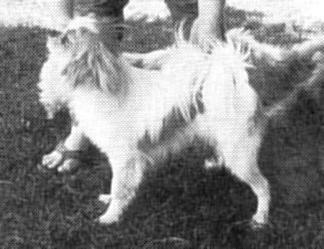





Prapso, or occasionally "Perhapso," is the name given to Lhasa Apsos which are pure bred but to all outward appearances closely resemble Tibetan Spaniels. One or more can be produced in a litter and it is perfectly possible that both parents are fully coated. Clearly it is now not considered wise to breed from Prapsos, but in the past some of the early breeders carried out experimental matings. Undoubtedly test matings can help careful breeders establish which dogs carry the genes and which do not, but if such a dog or bitch is sold or given away to a pet home, precautions should be taken that the animal is not used for breeding purposes, and that the new owners are made aware that their newly acquired canine friend does not look quite like the real thing! Indeed when I first became involved with the breed in the 1970s, someone I knew was actually selling such dogs to France with the pedigree marked "Tibetan Spaniel, Lhasa Apso breed." But that is another story. Although I have never personally bred a Prapso, those who have produced them have told me that they can usually be recognized by around the age of four weeks. By this time the puppy often already has a full set of teeth and is more active and noisier than its littermates. At this stage the coat pattern develops at much the same rate as a fully coated Lhasa Apso, but at seven weeks of age the hair on the muzzle disappears and eventually feet and forelegs become smooth. There is some feathering between elbow and ankle, and between the toes. Also at seven weeks, or thereabouts, the puppy may look finer in bone than its siblings, and its feet are often slightly elongated. Color seems not to play any part in whether or not a puppy is a Prapso, but the texture of coat can differ according to color. Some puppies do not display all of the characteristics of a Prapso but nonetheless grow only a very short coat, no more than about four inches (10 cm-) in length, and this of a harsh texture. Such a dog is usually known as a "half-and-halfer." In the various test matings which have been carried out over the years, mating a smooth to another smooth appears to have produced all smooth coats, while smooth to long has produced predominantly long coats with the occasional smooth. In about 1960 the late Thelma Morgan worked out some ratios, coming to the conclusion that about 6 percent of Lhasa Apsos had smooth coats. As the breed has grown so greatly in number since the 60s, it would now be difficult to establish any sort of ratio, but I suspect it is substantially lower, though unfortunately many Prapsos which are bred are simply not known about. It is important for breeders to recognize that those long coated Apsos which have a Prapso as a littermate stand a reasonable chance of being carriers of the smooth factor themselves, but this may not be expressed for many generations. The incidence of Prapsos is a complex one, particularly because the smooth factor is displayed so infrequently and is such an irregular pattern. Those breeders who do produce Prapsos or "half-and-halfers" would help their breed by talking about their problems openly so that steps can be taken to eradicate untypical coat patterns in future generations.
Permission to reprint this copyrighted material has been granted to Monique van Boxtel
|
